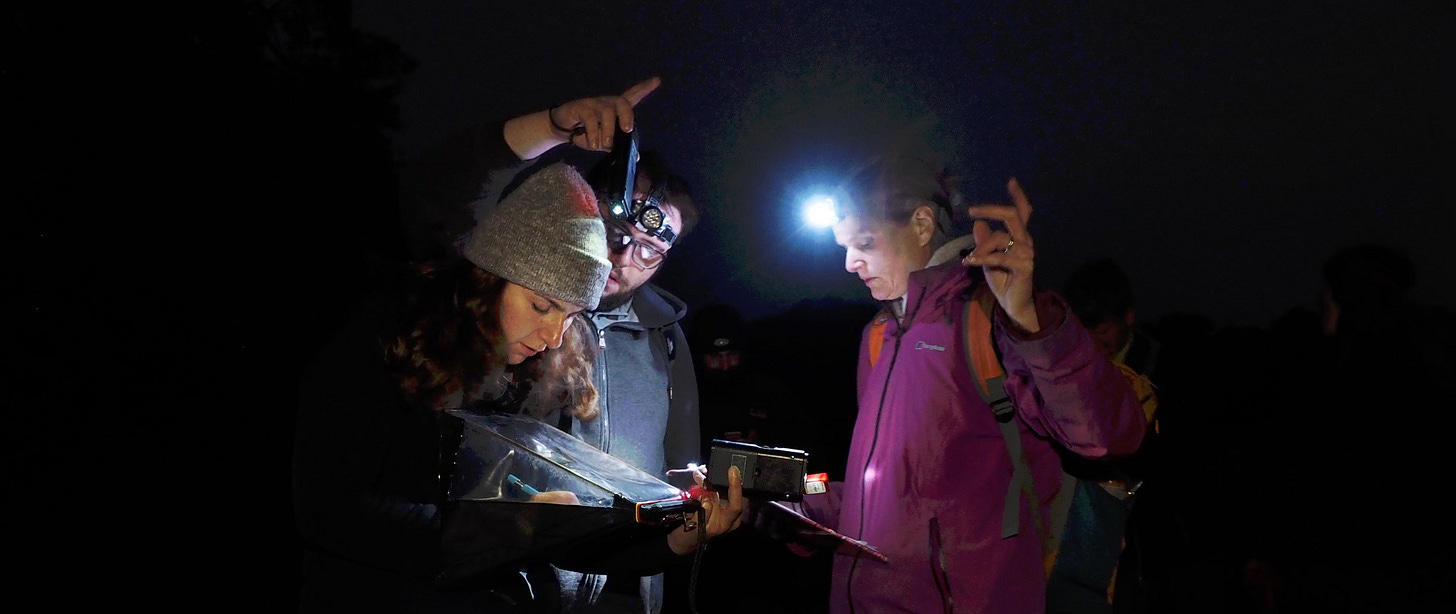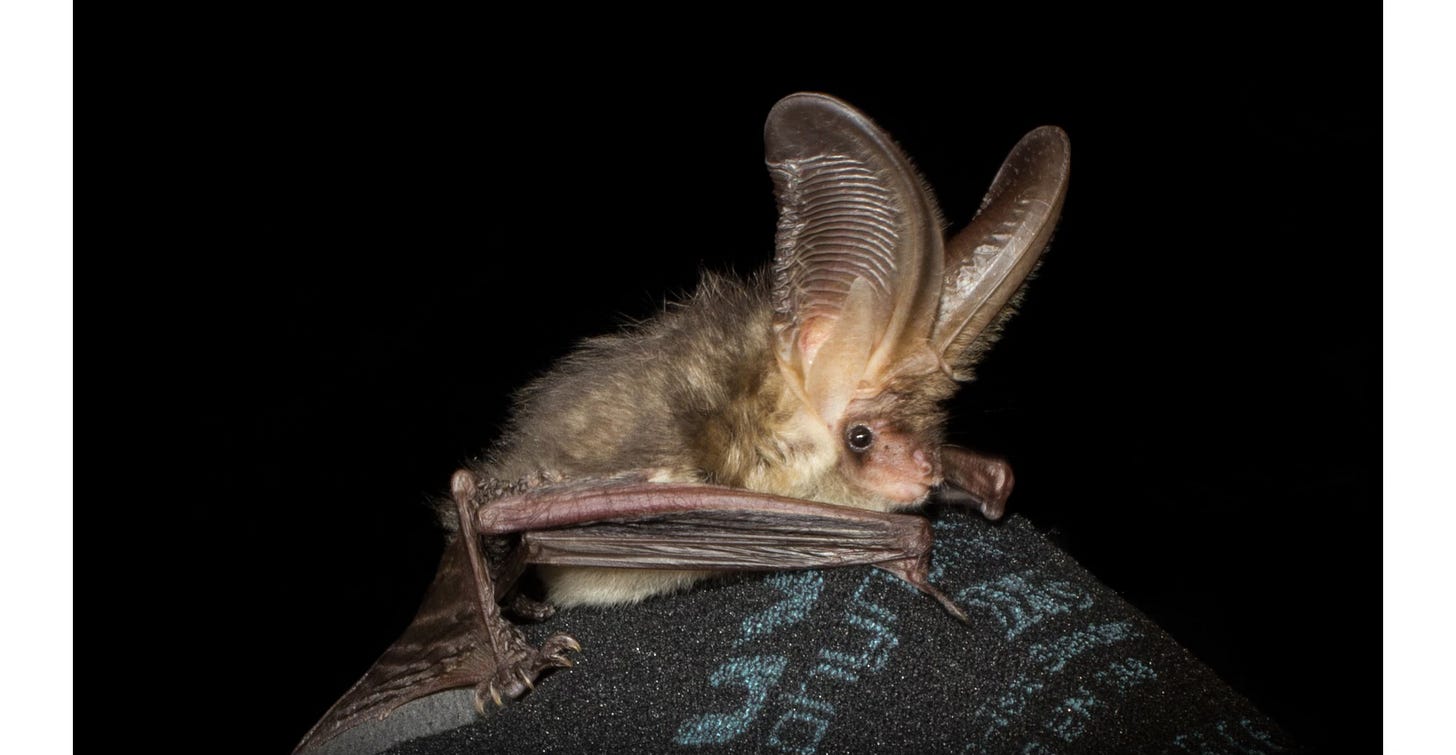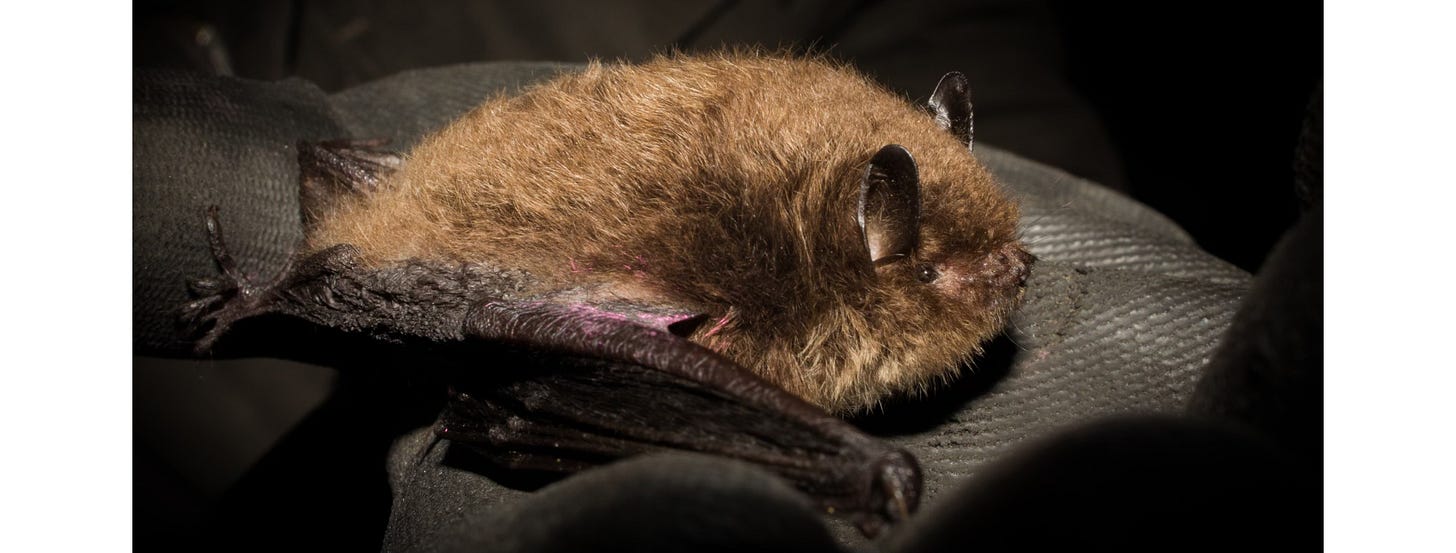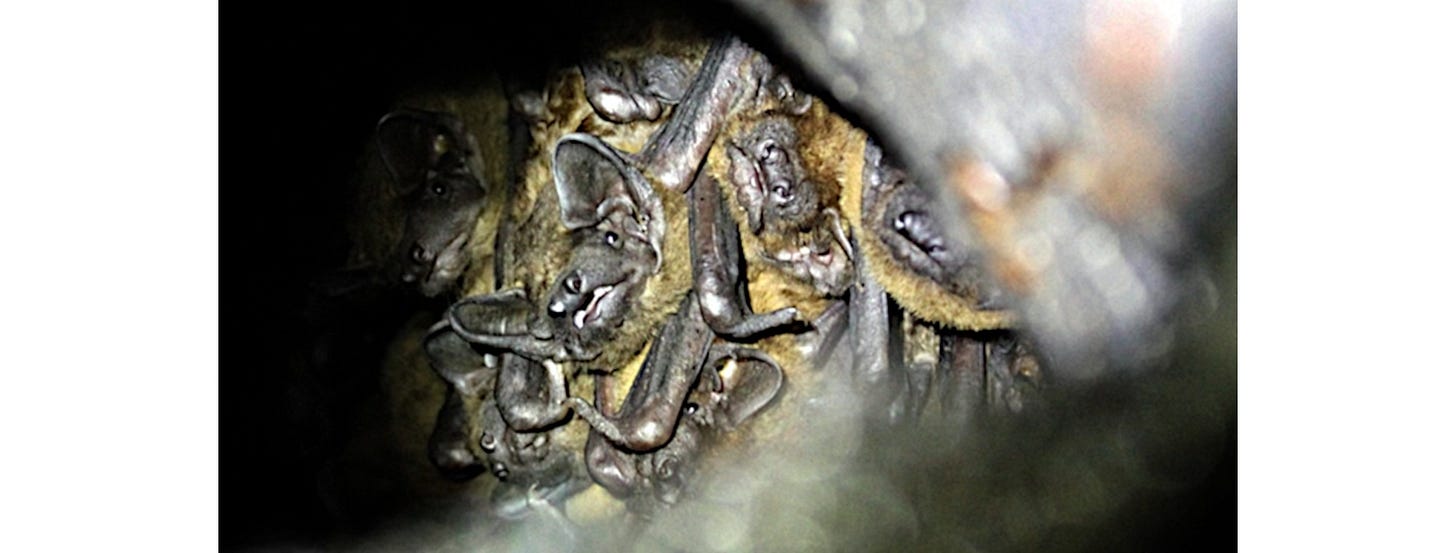Sunday at Bill's Mother's: 13th July 2025
Bat raspberries, snakes, horse droppings and absent Zebras.
Morning. It’s a good month for bats. They’ll be up there in a few hours, looking for moths and midges for their babies, being only a little less mysterious than they were in the first golden age for bat science a hundred years ago. But has new technology led to a new golden age of discovery for the nation’s flying mammals? And why do they blow raspberries?
We have a new piece from our Beginner Birder in The Secret Valley, where she sings the praises of muck heaps, and we hear how the city may soon see zebras everywhere, as campaigners ask why children still can’t walk to school safely.
Welcome to all the new subscribers who joined last week. Do try us out for free for a few weeks, then if you like what you read, a pocket money subscription is all we ask so we can cover the costs to keep going.
We’re a social enterprise of 310+ members so far, with a target of 380 full subscribers. At that point, we’ll be able to provide work to more freelance contributors to cover a lot more of this kind of thing.
Bat Signals
Click. Click click click click. Raspberry.
It’s almost dark, and around a dozen of us are wafting small ticking boxes in the air as we scan the tree canopy in Graves Park. Nicky Rivers and her colleagues from South Yorkshire Bat Group (SYBG) have equipped us with bat detectors, which tune in to the high pitched echo location cries of the small furry mammals that flutter above us on hot summer nights.
“I call that sound a bat raspberry,” says Nicky. “The clicks get closer and closer together as the bat gets nearer to an insect until it sounds like someone blowing a raspberry.” That raspberry sound is effectively the death cry of a bat-snaffled insect.
Not so long ago, no-one knew how bats caught moths and midges, Nicky explains. The principles of echo-location, where their high frequency bat calls bounce back so they can find prey in the darkness, were only discovered around 80 years ago.
And because bats are so hard to see, we’re only just working out how many species there really are, thanks to more precise sound and body analysis, and DNA records.
Now, some of the SYBG members have cunning red boxes plugged into their phones, displaying the sound signatures of bat calls and raspberries, and the species of bat involved. Some say the new technologies available mean we’re in a new golden age of bat research.
“There are lots different ways of being a bat,” says Robert Bell from SYBG. The species most of us know is the tiny black rag fluttering above our parks and gardens, the Pipistrelle. But there are 18 species in the UK, with 10 (or 11 if you go back to the 1970s) recorded in South Yorkshire.
This is the 20th anniversary year of the South Yorkshire Bat Group, originally founded in a Sheffield pub after an evening of bat enthusiasm. The group has around 100 members, including professional ecologists, keen amateurs and interested beginners.
Bats do crop up in the news now and then, but their dark and mysterious nature has always been their unique selling point. Newcomers are very welcome to come to a SYBG bat walk, or join the group, says Robert, with experts always happy to help beginners tell a Noctule from a Leisler’s, or a Common Pipistrelle from its cousin, the higher pitched Soprano.
Noctules are bigger than Common Pipistrelles, and soar, more like a bird, says Robert, but much higher so we rarely see them. And the Brown Long-eared Bat not only looks incredible, it’s a living example of the evolutionary arms race, he says.
Their ears are huge, to pick up their much quieter echo-location cries. Why? Because the moths they seek have evolved special ears on their backs to hear the sounds of bats trying to eat them.
“If they hear a bat, these moths just drop out of the sky in the hope the bat misses them,” says Robert. And the arms race continues, with ever quieter big-eared bats chasing moths with better bat signals on their backs.
At present, bats appear to be holding up quite well to the challenges of modern climate and habitat changes, but they had a very hard time last century, Robert says, when heavy use of agricultural insecticides killed off their food supplies. Their decline up to the 1990s now seems to have been arrested, he says, and bats have a flexible diet, which may help them cope when erratic weather disrupts the lives of different insects.
June and July are the months of maternity roosts, when female bats nurture their babies (usually one each) and males get themselves ready for the mating season in early autumn.
They’re not just like flying mice, as many think, says Robert. Unlike the much-preyed upon rodent, baby bats have a high survival rate, and some can live into their forties.
“Mating season is from September to November,” says Robert. “You get hundreds flying around after each other. Mating time is like a bat disco in a cave.”
SYBG lead field trips and walks in such places, not just to caves, but in former ganister mines or old railway tunnels. Members can also get training to help with bat surveys: bats and their roosts are protected by law, so both developers and curious householders can ask for an expert to check if bats are living in their darker spaces.
The visit to Graves Park is an official survey, carried out along with the national Bat Conservation Trust, and we follow a careful circuit, waiting for two minutes at fixed points to count the number of bat passes by different species. But there’s plenty of awestruck gazing into the treetops too.
The survey is carried out twice in July, just in case there’s terrible weather one evening. (Not so likely this year). The data sets will hopefully show how changes in the park might be affecting bat numbers.
We find lots of Common Pipistrelles, and the more expert among us (and their bat phones) detect at least one Noctule flying high above, and possibly a Leisler’s.
Then we arrive at the Graves Park lakes, retune our frequencies, and pick up click, click, click, at least ten passes by two or three Daubenton’s Bats.
A head torch sweeps across the pond and we pick out a series of tiny brown and white creatures skimming and wheeling, an inch from the surface as they pick off emerging water insects with their huge furry feet. Their alternative species name is Water Bat.
The clicking sounds seem far less relevant when you actually see these strange and bewildering animals going about their lives in the darkness of our city.
You can pick up a bat detector from about £65 (or £20-30 if you find one second hand, or build one yourself, says Robert) and you can get the sophisticated bat phone plug in from around £200.
Or, you can look for a bat walk on the SYBG website or social media page, or just go explore yourself: Crookes Valley Park, stretches of the upper Don, any dark and quiet watersides or woodlands are your best bet, says Robert.
“Interest is growing because bats are quite interesting,” he says. “But people sometimes ask what bats do for us. Well, they eat a lot of insects, so keep the pests down for farmers and gardeners. And they have an incredible capacity for fighting off disease, so there’s also growing medical research.”
An anticoagulant from South American vampire bats is now being analysed for the possible treatment of strokes and heart attacks, for example. It’s called Draculin.
For more information, see: South Yorkshire Bat Group
Beginner Birder in the Secret Valley - by Meghan Tipping
Since becoming a new birder, my senses have become more attuned to other wildlife at Shire Brook Valley. On my wildlife wanderings in search of birds I am often graced with other sightings.
While on a walk with an apprentice through the Valley in April, I spotted my first Common Newt! I had never one before, but as I stopped by one of the ponds, I was thrilled to see at least three wriggle to the surface before zooming back down.
I’ve learned that adults can be found in ponds where they spawn during the breeding season, their eggs are laid individually, each wrapped in the leaves of pond plants. In late summer, both juvenile newts and adults leave the water, and can often be found sheltering in damp soil beneath logs and rocks.
On another morning while photographing a meadow, I was startled by four Roe Deer diving up from the heather in front of me! I was not quite fast enough to take a picture, but it was a joy to see - I’d never been so close to a deer before. During our Bees, Butterflies and Botany event at the valley in May, I saw the same joy of discovery on the face of a young boy who’d just returned from the trail to report a sighting of a deer with his family.
In June, Mick Steeper (and his dog) spotted a Grass Snake under some trees at the northern edge of the reserve. “It was motionless for about a minute right under my feet,” he said. “Then it moved very quickly into the undergrowth.” Mick had two more Grass Snake sightings in June 2024, on the path alongside the Centenary Pond.
It was great to hear Mick’s news, as our volunteers have been making Grass Snake egg-laying heaps around the valley, thanks to generous donations of manure from nearby horses.
Historically Grass Snakes have used manure heaps for egg-laying because they generate the heat the snakes need to incubate and successfully hatch their eggs. But we have seen declines in Grass Snakes as agricultural practices change, and there are less heaps for snakes to lay their eggs.
So we hope our heaps across the valley will help boost grass snake numbers. Manure heaps can also provide shelter and overwintering sites for Slow-Worms, amphibians, invertebrates and small mammals such as Hedgehogs, mice and voles.
You can help too. Our ranger Nell says: “Compost bays with carpet on top to keep the heat in are a great place to find Grass Snakes and Slow Worms in your gardens.”
Find out more - Grass Snake | The Wildlife Trusts
Note: Grass Snakes are not poisonous, and generally harmless to people, but they may still bite and cause infection to dogs if they feel threatened, so be cautious if your curious dog (as they often do) spots a snake before you.
Missing Zebras
Try crossing Abbeydale Road at morning rush hour to Bannerdale Road. Now imagine you’re a small child, effectively invisible to SUV drivers sweeping round the corner.
I’m at the latest dazzle protest highlighting this problem. Parents, children and half a dozen people in zebra costumes are being approvingly honked at by drivers as they repeatedly cross the wide and complex junctions leading to Holt House nursery and junior school, and slightly further away, Carter Knowle Junior and Mercia Secondary.
There are 340 pedestrian crossings of this junction every weekday morning, says a member of the local Living Streets campaign group,
Parents tell me of regular near misses, and one says she anxiously hangs onto her kids trying to cross in the short ten second break for pedestrians in the morning traffic light phasing, knowing that impatient drivers often ignore the red lights anyway.
“I’ve had aggression just recently, when I told a driver they’d run a red light,” she says. “What’s more important, the smooth flow of traffic or kids lives?”
This is always the question. Local Green councillor Maroof Raouf says: “There’s a traffic camera so we know people are running the red light. Parents have said to me, is a child going to have to be sacrificed before we get a solution?”
Sheffield Council transport chair Ben Miskell calls to explain that yes, officers are working on a solution at Bannerdale Road, complicated by an extra exit to the four way junction from a local church, who he says are keen to help. “We’re determined to do something there,” he says.
He send me details of the council’s new Walking, Wheeling and Cycling Investment Plan, which I’ll be covering in more detail, and tells me the council and its planners will be led by data across the city, which yes, will include the number of people killed or seriously injured at road junctions, along with other information like perceptions of safety and the routes people want to take.
“The easiest thing to do as a politician would be to step away from this plan, and respond in a piecemeal way, depending on where the pressure happens to be on any given day,” he says, referring I think to zebra protests.
But that would take us back to the dark days of politicians making it up on the back of a cigarette packet, or doing whatever feels politically expedient before an election, he warns. “People campaigning for active travel improvements want to know we have an ambitious plan to change our city. And we do.”
I’ve been talking to the active trail advocates from South Yorkshire Combined Authority and Sheffield Council, and will have some longer posts soon about how we’ll be happily walking and wheeling around in future.
More What’s On Out There (from Sunday 13th July)
A tiny selection from our new (and regularly updated) What’s On Out There news and listings post for June and beyond.
Sun 13th - Yorkshire Rose Womens Cycle Rides
Mon 14th - Friends of Whirlow Brook Park volunteer session
Tues 15th - Friends of Ecclesall Woods volunteer & footpath repair session
Tues 15th - Sheffield Ramblers Walk - Meadows, from General Cemetery (5m)
Weds 16th - Sheffield Grand Prix city centre cycling
Weds 16th - Shire Brook Valley - Volunteer Session
Thurs 17th - SRWT Guided Walk - Butterflies at Woodhouse Washlands
Sat 19th - Parkwood Springs conservation volunteering
Sat 19th - Conservation Session, Wardsend Cemetery
Thanks for reading. And if you’ve enjoyed this week’s post, please remember our catchy tagline: F.F.S! - Forward to Friends and Subscribe!
Full access to every single post, and to our huge and fairly interesting archive, is for full members only. If you’ve been trialling us for a while, it’ll really make my Sunday if you take the very affordable plunge and upgrade below.












Re the possible (promised?) Bannerdale Crossing - which has been an ongoing issue for many years - I wouldn’t hold your breath.
The promised super-crossing on Abbey Lane between two of the three parts of Ecclesall Woods has been in a number of “design stages” for the last two years at least - leaving pedestrians, buggy-pushing parents, wheel-chair users and horse-riders to dodge speeding motorists, lorries etc. while trying to walk in their local woods. And don’t even ask about the appalling junction further up, where Abbey Lane and Whirlowdale Rd meet in a lop-sided cross-roads with no pedestrian provision at all - no islands, no traffic lights, no proper give-way lines.
A solution is promised - funded by the South Yorkshire Mayor Authority but with money which is being eroded year on year by inflation. By the time the design work, inter-agency disputes and “intractable conflicts” between pedestrian safety and (unofficial) ring-road traffic flow are sorted, all that’s likely to be left is funding for an apologetic sign saying ‘sorry we’ve run out of money/time/willpower etc.’
And the Abbey Lane Crossing Campaign also started with people holding up traffic dressed in zebra costumes!
Re the traffic crossing. I used to live in Crosspool where kids have to cross Manchester road to get to the schools. After a child was injured by a driver of a car there was a petition for a crossing signed by hundreds but it failed as it wasn’t deemed dangerous enough, ie no one had died.
On Lydgate lane there IS a zebra crossing because a child was killed by a driver.
It’s nuts.